- Home
- Dante Alighieri
Dante's Lyric Poems (Italian Poetry in Translation) Page 2
Dante's Lyric Poems (Italian Poetry in Translation) Read online
Page 2
That arrival is so far from preordained that, in the sonnet Io sono stato con Amore insieme, datable to between 1303 and 1306 (thus about a decade after the theologizing of love that had taken place in the Vita Nuova), love is characterized in antithetical terms as an irresistible force capable of dominating reason and free will: “Però nel cerchio della sua palestra / libero albitrio già mai non fu franco [So in the sphere of its authority / free will has never been completely free]” (9–10). Still more surprising, the poet claims to have experienced this passion for the first time in his ninth year, that is, toward Beatrice:
Io sono stato con Amore insieme
dalla circulazion del sol mia nona,
e so com’egli afrena e come sprona
e come sotto lui si ride e geme.
Chi ragione o virtù contra gli sprieme
fa come que’ che [’n] la tempesta suona …
(Io sono stato, 1–6)
[I’ve dwelled together with the god of Love
from when the sun had circled back nine times,
and I know how he checks and how he prods
and how one laughs and cries beneath his rule.
Opposing him with force or reason
is like sounding the alarm within a storm …]
Here the lover finds himself literally at the mercy of love, completely subordinated, to use a word that in Inferno 5 characterizes the lustful, those “che la ragion sommettono al talento [who subordinate reason to desire]” (Inf. 5.39). Foster-Boyde comment: “This is the more remarkable in that Dante is now about forty years old and has behind him not only the Vita Nuova with its story of an entirely sublimated ‘heavenly’ love, but also the series of canzoni that more or less directly celebrated a love that had its seat in the mind or intellect.”2
In short, Dante cannot be pigeonholed, not even by Dante himself. His lyrics are a salutary reminder of the dialectical progress of his evolution as a poet and offer the reader the opportunity to confront the radical shifts in his development, and to witness how far from predetermined his journey really was.
The Future of Interpretation
The lyrics highlight, sometimes implicitly and sometimes explicitly, themes of great topicality for Dante and for his audience.
Among the themes that run throughout Dante’s work, one of the most important is the great ethical theme of desire: is desire a compulsion that controls reason? Dante will explain clearly in the Commedia that “lume v’è dato a bene e a malizia,/e libero voler [a light is given to you on good and on evil, and free will]” (Purg. 16.75–6), but such an assertion is a conquest; we just saw that the sonnet Io sono stato asserts the opposite: “Però nel cerchio della sua palestra / libero albitrio già mai non fu franco [So in the sphere of its authority / free will has never been completely free]” (Io sono stato, 9–10). The early sonnet Savere e cortesia, addressed to Dante da Maiano, already posits the problem of compulsion and demonstrates the fatalistic solution that will recur later in Io sono stato, in the declaration that there is no power that can impede love: “ché nulla cosa gli è incontro possente [for nothing has the power to take him on]” (Savere e cortesia, 13). A version of the mature solution of the Commedia, in which desire can and must be governed by reason, is found instead in the post-exilic canzone Doglia mi reca.3 The theme of friendship, considered a subset of love within the ethical context provided by Aristotle’s Ethics and Cicero’s De Amicitia, is glimpsed in the sonnets Deh ragioniamo, Sonar bracchetti, Volgete gli occhi, Guido, i’ vorrei, and Amore e monna Lagia, where the concepts inherited from antiquity assume a new physiognomy against the courtly background.
The theme of friendship is not only philosophical / ethical but also social / historical, given the theoretical treatment of courtly life in a canzone like Poscia ch’Amor and the evocation in these sonnets of the life of the group. The exclusively male groups (brigate) glimpsed in certain texts (Sonar bracchetti, Volgete gli occhi) should be compared with the exclusively female brigate present for example in the sonnets Vede perfettamente and Di donne io vidi una gentil schiera. Taken together, these texts suggest the existence of a “sociology of the brigata” that can be extrapolated from the lyrics. The unusual mixed-gender company of men and women made famous by the Decameron is already present in the enchanted vessel of Guido, i’ vorrei.4
There is still much historical material to extract from Dante’s lyrics, above all in the areas of gender and social behaviour. The sonnets cited above as exemplars of the way in which Dante treats the theme of friendship are useful also for opening a window onto social relationships among men. The tenzoni with Dante da Maiano offer a glimpse of the behavioural codes that govern such relationships, from the veiled rivalry that runs through sonnets that are superficially friendly (“che di saver ver’ voi ho men d’un moco [compared to yours my learning is but scant],” writes Dante Alighieri in Qual che voi siate, amico, a sonnet in which the word amico pertains less to the lexical sphere of friendship than to that of professional interactions between poet-rivals), to the open aggression of Dante da Maiano in Di ciò che stato sè dimandatore. Many texts that until now have been read exclusively in terms of an ideology of love also document distant and stylized – but not irrecoverable – moments of social life. For example, the sonnets Voi che portate la sembianza umile and Se’ tu colui c’ hai trattato sovente tell the story of a poet who does not respect the boundaries established by his society with regard to the rituals of public mourning. The poet wants to participate in weeping, an activity that belongs to the women, who reaffirm their role and re-establish the boundaries dictated by social norms: “Lascia piangere noi e triste andare [Leave weeping and unhappiness to us]” (Se’ tu colui, 9). Exploring the transgressive impulses of the poet, the sonnets also end up offering a description (tenuous but nevertheless present) of female activity around mourning. There is no doubt that these sonnets and many others merit future in-depth analysis of their historical and anthropological background.5
The historical and civic realities of Dante’s world are visible as well in sonnets such as No me poriano, which refers to the famous “Garisenda / torre [Garisenda tower]” in Bologna, and Di donne io vidi, where reference is made to the feast of “Ognissanti [All Saints’ Day].” In both we can sense the daily life of the commune; the tower itself is emblematic of the internal factions in Italian cities, and in this sense of the politics of the era.6 The relationship between the social classes is touched upon in La dispietata mente, as is the exquisitely social question of honour, featured in the comparison in which the duty of the lady to satisfy the need of her lover is equated with the duty of a “buon signor [good lord]” who does not withhold help from his servant who calls on him, since by defending the servant he is also defending his own honour:
ché buon signor già non ristringe freno
per soccorrer lo servo quando ’l chiama,
ché non pur lui, ma ’l suo onor difende.
(La dispietata mente, 17–19)
[an honest lord will never hesitate
to aid his servant when he calls for help,
since he defends his honour, not just him.]
Present for the first time in La dispietata mente, the master-servant trope is one that Dante will frequently use in the treatises De vulgari eloquentia and Convivio as well as in the Commedia; it opens an unexplored window onto contemporary society.
Dante’s lifelong meditation on the craft of writing poetry is much in evidence in the lyrics, as is his intellectual engagement with the phenomenology of visions. The motif of Dante as visionary emerges very early in A ciascun’alma presa and in Ciò che m’incontra, and a very Dantean metatextual awareness may be found in many of the lyrics, for example in Se Lippo amico, Piangete, amanti, and Sonetto, se Meuccio. Dante’s characteristic strategies in the Commedia, such as the use of direct discourse for creating the illusion of immediacy and the textual contaminatio between various stylistic registers, are amply attested in the lyrics: one thinks, for instance,
of the fusion of courtly and biblical registers in the sonnets O voi che per la via and Ne le man vostre.
The lyrics also boast philosophical themes that we associate with Paradiso: already present in the early sonnet Guido, i’ vorrei is the great theme of the dialectic between the one and the many, between the irreducible self in its individuality and ontological differentiation on the one hand and the enchantment of non-differentiation – of the “gran mar de l’essere [great sea of being]” – on the other. In the canzone Donne ch’avete intelletto d’amore we witness the coniugatio of intellect and love that will be one of the principal themes of Paradiso. One instance among many is the fusion of the faculties of intellect and will in the verse that describes Saint Bernard, “Affetto al suo piacer, quel contemplante [Rapt in his pleasure, that contemplative]” (Par. 32.1), where the first clause corresponds to will and the second to the intellect. Another stunning testament to the links between Paradiso and Dante’s earliest poetry is the word leggiadria. Present in early courtly lyrics such as Morte villana and Per una ghirlandetta, it appears in the Commedia only at the summit of paradise, where it is used to describe the archangel Gabriel: “Baldezza e leggiadria / quant’esser puote in angelo e in alma,/tutta è in lui [All confidence and grace, as much as there can be in angel or in soul, is in him]” (Par. 32.109–11).7
Editorial History
In the absence of the author’s own ordering of the rime, various editorial viewpoints have prevailed over centuries of commentary and editorial history. The great editors of the twentieth century turned to a chronological ordering of the poems. Traditionally, in the manuscript collections, the lyrics were divided by genre, canzoni isolated from sonnets and from ballate. This, the editorial choice of the manuscript tradition, was recently restored by Domenico De Robertis in his monumental 2002 critical edition.
Each of the major editions over the span of the twentieth century and into the twenty-first is in its own way magisterial. The 1921 edition of the Rime edited by Michele Barbi, for the Società Dantesca Italiana,8 without commentary, establishes the textual nucleus from which his posthumous edition with commentary will take shape, carried to its completion by two disciples designated by Barbi himself, Francesco Maggini and Vincenzo Pernicone. Working with Barbi’s notes and integrating his material, published and unpublished, with their own research, Maggini and Perni-cone published their respective volumes, Rime della “Vita Nuova” e della giovinezza in 1956 and Rime della maturità e dell’esilio in 1969.9 Their efforts were scooped by the edition of the Rime with commentary published by Gianfranco Contini in 1939; this edition, immediately praised for its lapidary elegance, was subsequently reprinted with revisions and new materials in 1946 and 1965.10 The British scholars Kenelm Foster and Patrick Boyde published their translation with commentary in 1967.11 Lastly, in 2002 the critical edition edited by Domenico De Robertis came out, followed by his commentary in 2005.12 Already heralded by Contini in his just cited edition of 1965 (in the “Postilla del curatore”), De Robertis’ edition has supplanted Barbi’s as the official authoritative edition.
The unusual complexity of the editorial history of Dante’s lyrics is rooted in a problem that is structural in nature. Since Dante considered his own lyrics as texts that are independent or complete in themselves rather than as parts of a whole (although he eventually decided to make the lyrics included in the Vita Nuova and Convivio into parts of a whole, those poems too were originally conceived independently of a macrotext), each poem has an independent and individual editorial history. Hence the disheartening challenge for the editor, who must deal with the dispersion of the texts throughout a very high number of manuscripts and follow the course of transmission of every poem and of every group of poems in the various anthologies assembled by copyists.13 Pernicone, who had himself received the symbolic investiture from Barbi, entrusted to De Robertis in his turn the task of reconstructing the manuscript tradition of each poem: De Robertis’ 2002 edition is therefore the direct geneological successor of Barbi’s 1921 edition, completing the enormous undertaking of the recensio of the manuscripts that Barbi had projected.
Dante and Boccaccio, First Editors of Dante’s Lyrics
The most important editor-copyist in the editorial history of Dante’s lyrics is Dante himself, who includes some of his poems, and not others, in the Vita Nuova and Convivio. These choices had important consequences both for the ensuing transmission of the texts and for their literary fortune. Dante’s primal intervention and its ripple effects through time are thus a crucial part of the history I am recounting, and we must take into consideration the historical mechanisms of compensation and misrepresentation that developed in response to Dante’s choice to include some of his poems and not others in new macrotexts, which in turn developed their own editorial traditions and their own literary genealogies.14 With regard to literary history, I refer in particular to the line that carries from Dante’s Vita Nuova to Petrarch’s Rerum vulgarium fragmenta, a genealogy that bypasses and marginalizes Dante’s independent lyrics yet will have a decisive impact on the decisions of their editors.15
Second only to Dante himself in importance in the editorial history of the rime is Boccaccio, because of his transcription of fifteen canzoni that came to be known, from his notation, as the canzoni distese. Boccaccio transcribed the same fifteen canzoni in the same order on three occasions in three different codices (Toledano 104.6, Chigiano L.V.176, Riccardiano 1035). Recently it has been hypothesized that the anthology of fifteen canzoni existed before Boccaccio – that Boccaccio took the sequence from an unknown source preceding him.16 Even if this hypothesis could be verified, it would not change the fact that we possess the canzoni distese only through Boccaccio’s transcription, which had the effect of creating a homogeneous block of Dante’s lyrics (all canzoni) destined to become canonical: the fifteen canzoni that Boccaccio called “le canzoni distese di Dante [Dante’s extended, i.e., pluristrophic, or non-monostrophic, canzoni].” For ease of visualization, I list the fifteen canzoni distese in the order in which they appear in Boccaccio’s transcription:
Così nel mio parlar vogli’esser aspro
Voi che ’ntendendo il terzo ciel movete
Amor che nella mente mi ragiona
Le dolci rime d’amor ch’io solea
Amor che movi tua vertù dal cielo
Io sento sì d’Amor la gran possanza
Al poco giorno ed al gran cerchio d’ombra
Amor, tu vedi ben che questa donna
Io son venuto al punto della rota
E’ m’incresce di me sì duramente
Poscia ch’Amor del tutto m’ha lasciato
La dispietata mente che pur mira
Tre donne intorno al cor mi son venute
Doglia mi reca nello core ardire
Amor, da che convien pur ch’io mi doglia
Later anthologists copied Boccaccio, faithfully reproducing the fifteen canzoni distese as he transcribed them.
The First Printed Edition: Giuntina
Of the first printed lyric anthologies, none is more important than Sonetti e canzoni di diversi antichi autori toscani (Sonnets and canzoni of diverse ancient Tuscan authors), published in 1527 by the Florentine Giunti brothers, and hence more commonly known as the “Giuntina.”17 The Giuntina exercised authority both with respect to the text of Dante’s lyrics and with respect to the ordering of the poems, since it offers “the first proposal for systematizing and organizing Dante’s lyrics.”18 Dante has pride of place in the Giuntina. The Giunti brothers dedicate the first four books of their lyric anthology to Dante’s lyrical production, organized according to the following headings:
Sonetti e canzoni di Dante Alaghieri ne la sua Vita Nuova. Libro primo
Sonetti e canzoni di Dante Alaghieri. Libro secondo
Canzoni amorose e morali di Dante Alaghieri. Libro terzo
Canzoni morali di Dante Alaghieri. Libro quarto
The criteria of classification adopted by the Giuntina are vario
us. A formal criterion – traditionally, copyists grouped poems by genre, according to the hierarchical order canzoni-ballate-sonnets – is traceable in the decision to segregate only canzoni into books 3 and 4. A newer thematic criterion can be discerned, instead, in the selection of only what the compiler labels “moral canzoni” in book 4, which begins with the three canzoni from the Convivio (showing us that the error of categorizing all three Convivio canzoni as “canzoni morali” begins early), in the order adopted by Dante in the treatise, while book 3 groups amorous and moral canzoni together: “Canzoni amorose e morali.” Note the dependence of the printed edition on the editorial decisions of Dante himself: book 1 gathers the thirty-one mixed compositions (canzoni, sonnets, and ballate) selected by Dante for the Vita Nuova, respecting the order in which those poems are found in the libello, and respecting as well Dante’s innovation in mixing lyric genres. Moreover, there is an embryonic principle of chronological order at work in the Giuntina’s placement of the early Vita Nuova poems at the opening of its Dante sequence and his later canzoni at its end.19
Twentieth-Century Editions: Barbi, Contini, and Foster-Boyde
In the twentieth century the implicit chronological criterion of the Giuntina became the explicit basis for the ordering of Dante’s lyrics. Barbi, and after him, Contini – who takes up, without alterations, the sequence of compositions proposed by Barbi, which he calls an “ideal chronology” (Contini, 67) – insert the available empirical evidence into the overall chronological framework provided by Dante’s artistic career.
Barbi divides the eighty-eight poems published by him (to which he adds an appendix, “Rime di dubbia attribuzione” (Lyrics of doubtful attribution), which contains twenty-six poems) into seven books (as they had been called in the 1921 edition) or parts (as they were renamed in the later volumes of commentary), each of which is given a title. Barbi’s titles provide precise categories, analysing and anchoring the compositions according to a wide array of overlapping criteria. The first of these criteria is authorial-editorial in nature, with implications as well for issues of chronology and biography: by making “Rime della Vita Nuova” (Rime of the Vita Nuova) the first book of his edition, Barbi places himself in the editorial wake of the Giuntina, which in its turn followed Dante. Barbi continues with the chronological-biographical thread in his second book, “Rime del tempo della Vita Nuova” (Rime of the time of the Vita Nuova), and the same principle is applied to the seventh book, “Rime varie del tempo dell’esilio” (Various rime from the time of exile). Biographical-chronological criteria combined with formal and thematic considerations underlie the third book, “Tenzone con Forese Donati” (Tenzone with Forese Donati), while formally and biographically defined thematic principles sustain the fourth, fifth, and sixth books, respectively: “Rime allegoriche e dottrinali” (Allegorical and doctrinal rime; this section contains the canzoni in the Convivio), “Altre rime d’amore e di corrispondenza” (Other rime of love and correspondence), and “Rime per la Donna Pietra” (Rime for the Stone Lady). The seven books are arranged in an order that, on the whole, aims at being chronological.

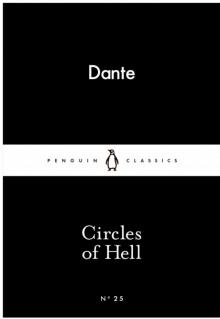 Circles of Hell
Circles of Hell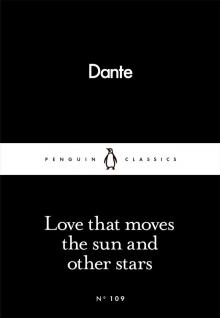 Love That Moves the Sun and Other Stars
Love That Moves the Sun and Other Stars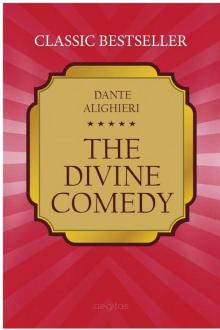 The Divine Comedy
The Divine Comedy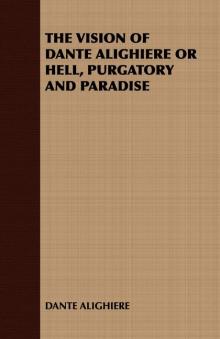 The Vision of Dante Alighiere or Hell, Purgatory and Paradise
The Vision of Dante Alighiere or Hell, Purgatory and Paradise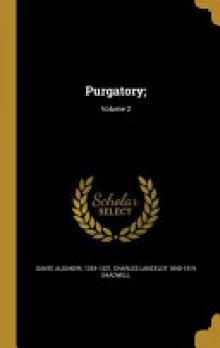 Purgatory
Purgatory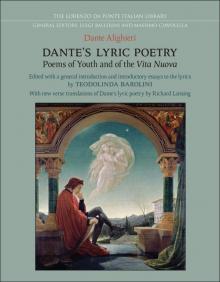 Dante's Lyric Poems (Italian Poetry in Translation)
Dante's Lyric Poems (Italian Poetry in Translation)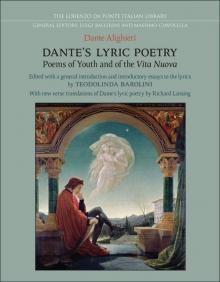 Dante's Lyric Poetry: Poems of Youth and of the 'Vita Nuova'
Dante's Lyric Poetry: Poems of Youth and of the 'Vita Nuova'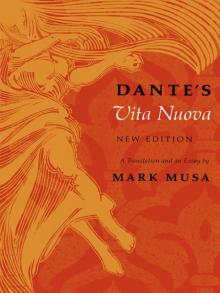 Dante’s Vita Nuova, New Edition: A Translation and an Essay
Dante’s Vita Nuova, New Edition: A Translation and an Essay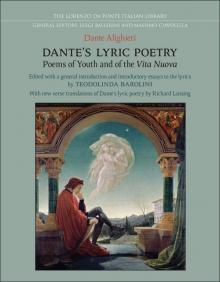 Dante's Lyric Poetry
Dante's Lyric Poetry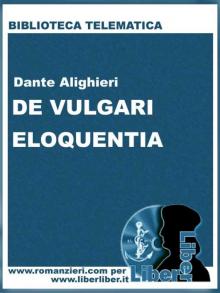 De vulgari eloquentia
De vulgari eloquentia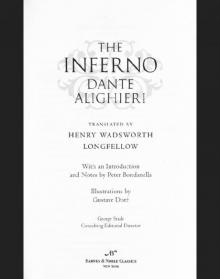 The Inferno (Barnes & Noble Classics Series)
The Inferno (Barnes & Noble Classics Series)